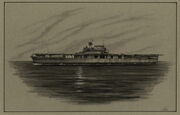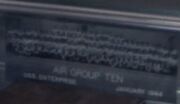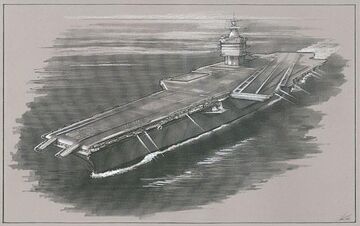 |
An aircraft carrier was a type of naval warship in Earth's 20th and 21st century. Its design and size allowed for aircraft, including fighters, bombers, and helicopters, to be launched and retrieved at sea. It was characterized by a long, flat "flight deck" which served as a mobile air base, condensing apron, landing strip, and runway into a small space. Many aircraft carriers after World War II were powered by nuclear fission.
In an alternate 1944, during World War II, the San Francisco Bay was home to aircraft carriers of the United States Navy. As Shuttlepod 1 flew into the bay, one aircraft carrier was entering the bay, while the other was anchored near Yerba Buena Island. Later, in New York City, Alicia Travers mistook an uniform patch and a subsequent non-committal statement by Jonathan Archer of Enterprise NX-01, as him having served on USS Enterprise (CV-6), which by that time had been sunk in the Pacific Ocean. (ENT: "Storm Front")
When the crew of the destroyed starship USS Enterprise traveled back in time to the year 1986, they collected nuclear radiation from the reactor of the USS Enterprise. This enabled them to recrystallize the dilithium of their captured Klingon Bird-of-Prey. (Star Trek IV: The Voyage Home) In 2364, a model of this carrier appeared in Admiral Gregory Quinn's guest quarters on the USS Enterprise-D. (TNG: "Coming of Age")
By the 22nd century it had become a tradition in Starfleet that its starships honored their historical namesake aircraft carrier predecessors with representations of them in any of their interiors; Enterprise (CVN-65) was represented as a painting in Captain Archer's ready room aboard Enterprise NX-01, whereas the same vessel was in the 24th century represented as a bas-relief in the observation lounge of USS Enterprise-D. (ENT, TNG) Captain Archer also kept a contemporary photograph of one of Enterprise (CV-6)'s squadrons in his ready room, Air Group Ten. (ENT: "Twilight") In the 23rd century a representation of Enterprise (CV-6) herself was displayed in a gallery on the recreation deck of the refit-USS Enterprise (NCC-1701). (Star Trek: The Motion Picture)
| Watercraft types |
|---|
| aircraft carrier • barge • boat • brig • clipper ship • destroyer • felucca • fishing boat • galleon • gondola • hydroscoot • hydro-skimmer • ice-cutter • ironclad • nuclear vessel • ocean-going vessel • passenger liner • pulse-rigger • raft • rowboat • sailboat • sailing ship • scouter-gig • slave ship • steamship • submarine • surfboard • war galley • whaling ship |
Appendices
Background information
The very distinctive profile[1] of the uppermost carrier in the San Francisco Bay scene in "Storm Front", strongly suggested it was a member of the pre-World War II Yorktown-class to which USS Enterprise (CV-6) had belonged, and after which Gene Roddenberry had named his Star Trek: The Original Series USS Enterprise starship. As she was declared already sunk by Travers, this, historically at least, only left her three class sisters as possible candidates, USS Yorktown (CV-5), after which Roddenberry had originally named his starship in his 1964 Star Trek is... pitch, the scaled-down USS Wasp (CV-7) version, or USS Hornet (CV-8, the penultimate American carrier to be destroyed in the war), all of which having in actuality already been sunk by the Japanese Navy by January 1943. Enterprise, having participated in all Pacific campaigns save for the Battle of the Coral Sea, ironically became the sole class survivor and one of history's most celebrated vessels, much like its fictional starship counterpart. The San Francisco Bay scene in "Storm Front" was entirely executed as a CGI effect at digital effects company Eden FX. (end credit roll)
As it turned out, all Yorktown-class sister ships were considered at the start of the second season of The Original Series by Producers D.C. Fontana and Robert H. Justman as namesakes for starships belonging to, what they at the time still called, the Starship-class, USS Yorktown having been introduced into the franchise at a later time in dialogue in the second season episode "Obsession" (though never firmly established in canon as being Constitution-class). The annotations on their memos made it very clear that the two Star Trek staffers very much indeed had the WW II carriers in mind when making the name suggestions, and not any other, prior historical vessel,[2] as was abundantly evidenced by the remark Justman made on his memo of 9 August 1967, which read, "I think there would be several other candidates, such as Saratoga and perhaps another English carrier, a French carrier, a Russian carrier and certainly a Japanese carrier."[3] (The Making of Star Trek, pp. 164-165)
Other Constitution-class vessels named after aircraft carriers include:
- USS Lexington – after USS Lexington (CV-2), the class vessel and class-sister of the by Justman-suggested Saratoga,[4] and/or USS Lexington (CV-16), an Essex-class, the latter being renamed from USS Cabot to honor the former when it was lost in the Coral Sea (as were class-sisters USS Yorktown (CV-10), USS Hornet (CV-12), and USS Wasp (CV-18) in honor of their by then lost Yorktown-class predecessors). Lexington was later followed by carrying the name.
- USS Intrepid – after USS Intrepid (CV-11), another Essex-class.
- USS Constellation – after USS Constellation (CV-64), a Kitty Hawk-class, and the only post-WW II carrier in the list of name suggestions. Starfleet followed for this vessel as well.
- USS Eagle – after the British carrier HMS Eagle (no class and sunk in the Mediterranean Sea, after having fought alongside the original USS Wasp CV-7).
- USS Essex – after the class vessel USS Essex (CV-9) – nearly made the cut at the time initially, as it was already referenced to in first script draft dialogue treatment, dated 30 September 1967, page 64, for the second season episode "Journey to Babel", which contained a line having Lieutenant Uhura state, "Starfleet Command confirms alien attack on the other starships, sir. The enemy was defeated. Starships Essex and Eagle suffered heavy damage, but will make base."
The above reference to the Essex and the Eagle, though, was dropped from the episode as aired, [3] but USS Eagle resurfaced a quarter of a century later in Star Trek VI: The Undiscovered Country, referenced in the "Operation Retrieve" mission charts, courtesy of Michael Okuda. Even Essex resurfaced as the Daedalus-class USS Essex (NCC-173) in the Star Trek: The Next Generation season five episode "Power Play".
At least three other starships, established by production staffers as being named after aircraft carriers, were later added to canon in the Star Trek: The Next Generation fifth season episode "Redemption II" and the Star Trek: Voyager third season episode "Unity", which included,
- USS Akagi (NCC-62158), a Rigel-class – after IJN Akagi (ex-Amagi-class, and at long last fulfilling Justman's wish to have a Japanese carrier included in Starfleet.)
- USS Hornet (NCC-45231), a Renaissance-class – after the original suggestion of Fontana and Justman, it too was finally inducted into canon. It was actually the inclusion of Hornet that prompted episode Writer Ronald D. Moore to champion Akagi (which had taken part in the raid on Pearl Harbor); as the two carriers were direct adversaries in the bitterly contested June 1942 Battle of Midway, Akagi being sunk in that battle, Moore felt it only fitting that in Star Trek's future both vessels would serve alongside each other. (Star Trek Encyclopedia, 4th ed., vol. 1, p. 14)
- USS Roosevelt (NCC-2573), an Excelsior-class – after USS Theodore Roosevelt (CVN-71), a Nimitz-class ship. (Star Trek Encyclopedia, 4th ed., vol. 2, p. 237)
Other Starfleet vessels potentially named after aircraft carriers, but not confirmed either way by production sources, included,
- USS Hermes (NCC-10376), an Antares-class – after British carrier HMS Hermes, the very first carrier in history specifically designed as such (not being a conversion from an existing ship, as all its predecessors had been), but lost in World War II, ironically sunk by planes from Akagi.
- USS Princeton (NCC-59804), a Niagara-class – after either USS Princeton (CVL-23), an Independence-class vessel, and the last American carrier to be sunk in World War II, and/or USS Princeton (CV-37), an Essex-class vessel renamed for the former Princeton lost in battle, as was by then customary in the US Navy[5].
- USS Melbourne (NCC-62043), an Excelsior-class) – after HMAS Melbourne (R21), a Majestic class aircraft carrier of the Royal Australian Navy.
In The Voyage Home, the "part" of USS Enterprise (CVN-65) was actually filled by the conventionally-powered Forrestal-class USS Ranger (CV-61) because Enterprise, on which the producers had actually wanted to shoot the scenes, was on deployment at the time of the movie's filming. Most of the (background) performers seen aboard the carrier were actual Ranger crew. (Star Trek Encyclopedia, 4th ed., vol. 1, p. 245) Incidentally, Ranger also stood in for CVN-65 in several scenes shot for the aviation film Top Gun of the same year.
 |
 |
The painting of Enterprise (CVN-65) in Archer's ready room was one of a series of four illustrations depicting the historical lineage of Enterprise and made by Production Illustrator John Eaves, who, due to his own oversight, had only 24 hours to produce the drawings. Actually, Eaves had produced a series of five; however, due to space limitations on the wall, one had to be left out. The one chosen to be left out portrayed Enterprise (CV-6). Arguably, this was because CVN-65 had been the more prominently featured one in the Star Trek productions visually, contrary to the fleeting one-time visual appearance of CV-6 in The Motion Picture, apart from the one oral reference in "Storm Front", thereby establishing a visual continuity. [4] Set Decorator James Mees hinted at this when he stated, "We were trying to show that [Archer] was someone who had a past, a good past, and who remembered that past; that's what the show is so much about." (Star Trek: The Magazine Volume 3, Issue 3, p. 85) Nonetheless, one ephemeral reference to CV-6 was retained in Archer's room as set dressing, the Air Group Ten photograph.
During the production of Star Trek: Enterprise, copies of The Voyage Home were especially flown to her namesake Enterprise (CVN-65), being again on deployment, so that her sailors could enjoy for themselves the fictional events which supposedly took place on their ship. Several Enterprise crew members subsequently made cameo appearances as Starfleet dignitaries in the series' episode "First Flight", before she was decommisioned in 2012, having in turn become nicknamed "the Starship," after her fictional counterpart. (Star Trek Encyclopedia, 4th ed., vol. 1, p. 245)
The shooting script for Star Trek: The Motion Picture described the length of the long range shuttle Surak to USS Enterprise (NCC-1701) as "about the size of a fighter aircraft floating in over the vastness of an aircraft carrier".
According to Star Trek: Deep Space Nine Technical Manual (p. 83), Earth-based aircraft carriers were phased out in 2051.
Footnotes
- ↑ The superstructure on top of a Yorktown-class carrier, called the "island" in naval parlance, appeared at a distance as a solid, single-piece rectangular shape due to its massive funnel structure into which the bridge and other operational centers were incorporated. The prior Lexington-class had a two-piece island, whereas the ubiquitous subsequent Essex-class had a triangularly shaped island profile.
- ↑ That the minds of the Original Series producers were preoccupied with aircraft carriers should hardly come as a surprise if one realizes that Roddenberry and Justman (an US Navy war veteran himself) in particular, belonged to a generation of Americans for whom Yorktown, Enterprise, and Hornet were household names – as acknowledged by Alicia Travers' instantaneous recognition of Enterprise in "Storm Front". (These Are the Voyages: TOS Season One, 1st ed, pp. 28-29) The three sibling vessels became veritable instant celebrities for two signature 1942 actions: the April morale-boosting Doolittle Raid (in which Yorktown had not participated) after the devastating Japanese raid on Pearl Harbor (only missed by hours by Enterprise herself – even though several of her inbound planes were shot down by Japanese fighters over Pearl Harbor), and the even more signature June, fortunes-of-war turning, Battle of Midway, in which the three sisters attained near-legendary status overnight, even though Yorktown was lost in the battle. Wasp, after having fought alongside British carrier HMS Eagle in the Mediterranean Sea, was transferred from the Atlantic to replace her, only to be sunk herself a mere three months later.
World War II veteran Roddenberry himself has reaffirmed this in a later 1973 radio interview (approximately 9 minutes into the interview) regarding the renaming of Yorktown to Enterprise, by stating that he was, "(..)particularly fascinated by the story of the Enterprise in WWII which had Midway really turn the tide of the whole war. And I always considered it a heroic ship, and decided to use the name." [1] [2] - ↑ Though there had been plenty of historical Japanese aircraft carriers to choose from, the eventually-chosen USS Kongo had in actuality been a World War I-II era Japanese battleship, whereas the Russians had, up until that point, not yet operated a carrier. A similar case applied to the eventually chosen USS Hood, which was named after the famed World War II British battlecruiser and replaced the initial USS Eagle suggestion, even though there had likewise been plenty of contemporary British counterpart carriers to choose from.
- ↑ Several starships carrying the name were at a later point in time added in canon though.
- ↑ The US Navy utilized the instantaneous renaming practice predominantly for aircraft carriers, as these had become the most valuable assets in the war against Japan. Aside from honoring these lost ships, it also served to confuse Japanese intelligence at the time.
External links
- Aircraft carrier at Memory Beta, the wiki for licensed Star Trek works
- Aircraft carrier at Wikipedia
